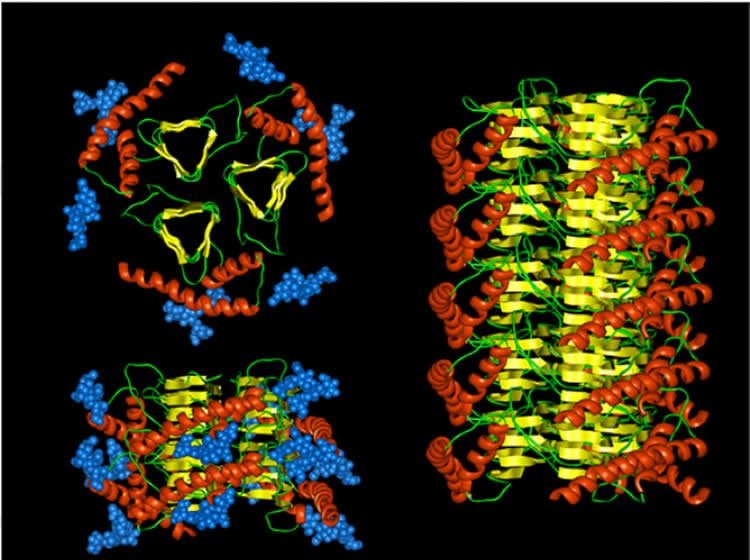“They will help us understand the precise mechanisms by which prions cause illnesses like Mad Cow or Creutzfeldt-Jakob disease.”
SISSA, in collaboration with the Carlo Besta Neurological Institute in Milan, established ideal lab conditions to create synthetic prions which act like biological ones, in a repetitive manner. “It is the first time that something like this has been done, and the consequences for research are significant.”
“Synthetic prions produced in a series allow precise control over their pathogenic behavior in experiments,” explains Giuseppe Legname, coordinator of the study whose lab techniques and results will be published in PLOS Pathogens. Working with ‘natural’ prions is not always so simple. “They are complex and heterogeneous,” says Legname, noting they are often complicated to use. “The synthetic ones we created ourselves, however, are easier to control, homogeneous and structurally defined. And yet they still show the same consequences as biological ones. Our ultimate goal, of course, is to identify mechanisms which can block the pathogenic effect, in order to develop treatments for disease.”

In the study, Legname and colleagues synthesized mouse prions, verifying their role in causing illness, which proved comparable to natural prions. “When we ‘characterized’ them, we also observed that they were very similar to the ones responsible for Mad Cow and Creutzfeldt-Jakob disease, the human form of the illness.”
Not just ‘Mad Cow’
“Naturally, our line of research is already evolving. We will be working with human prions, and we have other projects as well,” says Legname. He is referring to the hypothesis which is becoming more and more scientifically sound, that at the base of most neurodegenerative disease there are molecules with mechanisms similar to those of prions. “We are thinking about the molecules responsible for Alzheimers, like amyloid beta, or Parkinsons, or even amyotrophic lateral sclerosis. In these cases as well, having synthetic molecules available could be an important step forward.”
Source: Federica Sgorbissa – SISSA
Image Source: The image is adapted from the SISSA press release
Original Research: Full open access research for “Synthetic prions with novel strain-specified properties” by Fabio Moda, Thanh-Nhat T. Le, Suzana Aulić, Edoardo Bistaffa, Ilaria Campagnani, Tommaso Virgilio, Antonio Indaco, Luisa Palamara, Olivier Andréoletti, Fabrizio Tagliavini, and Giuseppe Legname in PLOS Pathogens. Published online December 31 2015 doi:10.1371/journal.ppat.1005354
Abstract
Synthetic prions with novel strain-specified properties
Prions are infectious proteins that possess multiple self-propagating structures. The information for strains and structural specific barriers appears to be contained exclusively in the folding of the pathological isoform, PrPSc. Many recent studies determined that de novo prion strains could be generated in vitro from the structural conversion of recombinant (rec) prion protein (PrP) into amyloidal structures. Our aim was to elucidate the conformational diversity of pathological recPrP amyloids and their biological activities, as well as to gain novel insights in characterizing molecular events involved in mammalian prion conversion and propagation. To this end we generated infectious materials that possess different conformational structures. Our methodology for the prion conversion of recPrP required only purified rec full-length mouse (Mo) PrP and common chemicals. Neither infected brain extracts nor amplified PrPSc were used. Following two different in vitro protocols recMoPrP converted to amyloid fibrils without any seeding factor. Mouse hypothalamic GT1 and neuroblastoma N2a cell lines were infected with these amyloid preparations as fast screening methodology to characterize the infectious materials. Remarkably, a large number of amyloid preparations were able to induce the conformational change of endogenous PrPC to harbor several distinctive proteinase-resistant PrP forms. One such preparation was characterized in vivo habouring a synthetic prion with novel strain specified neuropathological and biochemical properties.
“Synthetic prions with novel strain-specified properties” by Fabio Moda, Thanh-Nhat T. Le, Suzana Aulić, Edoardo Bistaffa, Ilaria Campagnani, Tommaso Virgilio, Antonio Indaco, Luisa Palamara, Olivier Andréoletti, Fabrizio Tagliavini, and Giuseppe Legname in PLOS Pathogens. Published online December 31 2015 doi:10.1371/journal.ppat.1005354







